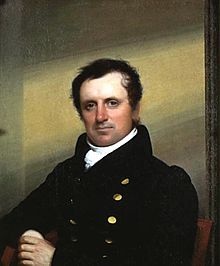Fenimore Cooper's Literary Offenses

"Fenimore Cooper's Literary Offenses" is an 1895 essay by Mark Twain, written as a satire and criticism of the writings of James Fenimore Cooper.[1] It draws on examples from The Deerslayer and The Pathfinder from Cooper's Leatherstocking Tales.
The essay is characteristic of Twain's biting, derisive and highly satirical style of literary criticism, a form he also used to deride such authors as Oliver Goldsmith, George Eliot, Jane Austen, and Robert Louis Stevenson.[2]
Summary[]
Twain begins by quoting a few critics who praise the works of Cooper: Brander Matthews, Thomas Lounsbury and Wilkie Collins. He then claims that they have never read the novels themselves, and that Cooper's work is seriously flawed:
In one place in "Deerslayer," and in the restricted space of two-thirds of a page, Cooper has scored 114 offenses against literary art out of a possible 115. It breaks the record.[3]
He goes on to list 18 separate literary rules he feels that Cooper does not follow, such as "The tale shall accomplish something and arrive somewhere. But the "Deerslayer" accomplishes nothing and arrives in the air," and "The author shall use the right word, not its second cousin." Twain continues on with few positive things to say about Cooper's writing, citing several examples from Cooper's writing to illustrate the unbelievable excess of the style.[3]
Reception[]

Twain's essay has been criticized by proponents of Cooper as unfair and distorted.[4] Cooper scholars Lance Schachterle and Kent Ljungquist write, "Twain's deliberate misreading of Cooper has been devastating....Twain valued economy of style (a possible but not necessary criterion), but such concision simply was not a characteristic of many early nineteenth-century novelists' work."[5]
Similarly, John McWilliams comments:
Hilarious though Twain's essay is, it is valid only within its own narrow and sometimes misapplied criteria. Whether Twain is attacking Cooper's diction or Hawkeye's tracking feats, his strategy is to charge Cooper with one small inaccuracy, reconstruct the surrounding narrative or sentence around it, and then produce the whole as evidence that Cooper's kind of English would prevent anyone from seeing reality.[1]
Twain critic Sydney Krause, while agreeing that the "sulfurous grumblings over Cooper [are] hardly the work of a judicious person," sees Twain's satire as an attack on Romanticism in general and a formal announcement that Romantic literature "was a literary dead letter in post-Civil War America."[1]
Joseph Andriano, writing in The Mark Twain Encyclopedia, says that Twain has "Imposed the standards of Realism on Romance" and that this incongruity is a major source of the humor in the essay.[6]
Everett Emerson (in Mark Twain: A Literary Life) says the essay is "possibly the author's funniest".[7]
Continuation[]
A second essay, continuing and completing the original essay, was published after Twain's death under the title "Fenimore Cooper's Further Literary Offenses" in The New England Quarterly (vol XIX, pp. 291–30, September 1946) as edited by Bernard DeVoto.[6] It was reprinted under the title "Cooper's Prose Style" in the collection Letters from the Earth (on pp 139–150 of the 2004 Harper edition).[8] This essay includes the passage which explains the "114 out of a possible 115" mentioned in the original essay. It is discussed in the "Editor's Notes" in the Letters from the Earth collection.[9] Everett H. Emerson says that the sequel is "less funny but still amusing."[7]
References[]
- ^ a b c "Fenimore Cooper's Literary Offenses (Introduction)". Twain's Indians. University of Virginia. Retrieved 31 December 2012.
- ^ Feinstein, George W (January 1948). "Twain as Forerunner of Tooth-and-Claw Criticism". Modern Language Notes. 63 (1): 49–50. doi:10.2307/2908644. JSTOR 2908644.
- ^ a b Twain, Mark. "Fenimore Cooper's Literary Offenses". Twain's Indians. University of Virginia. Retrieved 31 December 2012.
- ^ Schachterle, Lance & Ljungquist, Kent (1988). Myerson, Joel (ed.). "Fenimore Cooper's Literary Defenses: Twain and the Text of The Deerslayer". Studies in the American Renaissance. Columbia, SC: University of South Carolina Press. pp. 401–417.
- ^ Schachterle & Ljungquist, p. 410
- ^ a b Andriano, Joseph (1993). The Routledge Encyclopedia of Mark Twain. p. 287. ISBN 978-0824072124. Online excerpt.
- ^ a b Emerson, Everett H. (1999). Mark Twain: A Literary Life. University of Pennsylvania Press. p. 206. ISBN 0812235169.
- ^ "Bibliographical Note" in Letters from the Earth(1962) p.319 of the 2004 Harper edition, ISBN 978-0-06-051865-3
- ^ On p. 301 of the 2004 Harper edition
External links[]
| Wikisource has original text related to this article: |
- Fenimore Cooper's Literary Offenses at Project Gutenberg
- Fenimore Cooper's Literary Offenses at the University of Virginia
 Fenimore Cooper's Literary Offenses public domain audiobook at LibriVox
Fenimore Cooper's Literary Offenses public domain audiobook at LibriVox- Cooper’s Prose Style at Llumina Press
- Essays by Mark Twain
- James Fenimore Cooper